Whats the best sailing hat? According to our reader survey, there are as many answers to that question as there are hats on the market. Testers set out to find the best wide-brimmed sailing hat that offers lots of sun protection, even in a blow, and is breathable, lightweight, and well-made.
What We Tested
The test field included classic sailing hat favorites like the Tilley, as well as a few PS reader picks that we hadnt heard of. The 14-hat lineup represented six manufacturers and a range of mens and womens hat styles, including safari-style hats, gardener hats, and even a straw sun hat. We excluded baseball hat styles this go-around, but you can find our last caps review in the October 2008 issue.
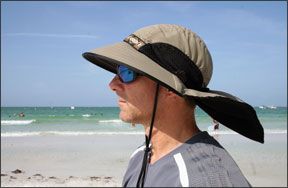
Product photos courtesy of manufacturers
The hat that is probably the most synonymous with sailing is the Tilley hat. Founded 30 years ago by sailor Alex Tilley, who sought to create a proper sailing hat, Tilley Endurables now sells a range of traveling apparel, all made in its home country of Canada. We tested the Tilley LTM10 Back-Vent Nylamtium, LTM2 Airflow Nylamtium, and the T4MO Organic Cotton Airflow.
Gill North America, the U.S. arm of the well-known marine retailer, recently released a new sailing hat, the Gill Technical UV Sun Hat (140), so we were keen to include it in the test field.
Outdoor apparel and gear giant Columbia Sportswear started out as a hat company, 75 years ago. From Columbia, we tested one straw hat, the womens Packable Sonoma, and two nylon/polyester hats, the womens Sun Goddess Booney and the Bora Bora II Booney.
We also had test products from two companies headquartered in the Pacific Northwest. Seattle-based Outdoor Research, an outdoor outfitter for more than 30 years, submitted its popular Seattle Sombrero, the Sombriolet Sun Hat, and the Helios. The Oregon-based Sunday Afternoons, a 23-year-old family-run company, also submitted its Cruiser, Charter, and Adventure hats. Rounding out the lineup was the Cov-Ver Supplex Boater Hat, which testers picked up from a retail vendor during the hot and sunny Miami boat show. The maker sells the hat mostly through wholesale, but its often found on the racks at boating events or from online retailers.
All of the test hats have brims that measure 2 inches or more, and were designed to protect the wearer from the elements. They range in price from $23 to $84.
Most of the hats feature special construction materials or special coatings. Columbias Omni Wick, Omni Shade, and Omni Freeze technologies are built into their hats, and the Sunday Afternoons hats feature ShieldTek water-repellent material and DermaSafe UPF50+ sun protection. Outdoor Research offers several Gortex hats for fighting rain and spray. The fabric used in all Tilley hats is certified to block 98 percent of harmful UVA/UVB radiation and has a UPF 50+ rating, according to the company.
Construction materials ranged from Gortex to straw, and included nylon, spandex, paper (yes, paper), polyester, and organic cotton.
Some hats look great on the dock and offer sun protection-even keep our heads warm and dry in the rain-but when the wind starts blowing, and we have to throw a reef in the main, we need a hat that will stay on. Sailing hats should have a chin strap, lest they become sailing buoys; all of our test hats had the requisite strap.
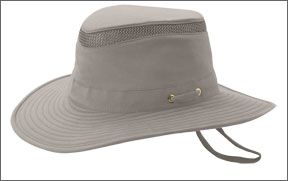
Whether a hat needs to be ventilated or be waterproof-or both-depends on where you sail, so we noted this during testing. Because color and styling are subjective, we did not weigh them heavily in our ratings but we did take into consideration whether multiple color choices were available in the various designs.
Fit is incredibly important. If a hat is not comfortable, few sailors care how well it works. Some hats came in sizes traditionally marked as small, medium, large with tips on choosing the right size for your noggin, while others took the one size fits most approach. Tilley takes the cake in the fit and sizing department, offering each hat in 11 sizes, along with instructions on how to measure your head.
How We Tested
To evaluate the hats performances, testers put them into real-world, everyday use and carried out bench tests. Each hat was worn in varying conditions, in the wind and rain, during temperate days and high-humidity Florida summer scorchers, on board and ashore. Testers examined each hat for the level of sun protection they offer, construction quality, durability, ventilation, fabric and material breathability, and how they performed in a breeze. Testers also noted their weight (wet and dry), fastening systems, and fit.
Testers measured the shade circumference of each hat and ranked them accordingly; the ratings listed in the Value Guide are relative to the field. To determine the hats ability to protect and stay on in a stiff breeze, testers donned each one during a summer rain squall, facing into the wind to see how they held up.
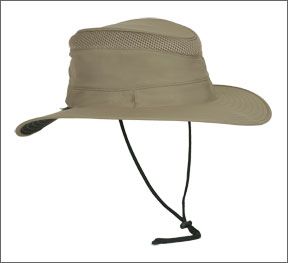
To determine whether the hats sink or float, we tossed them into the saltwater Gulf of Mexico and repeated the test with the hats turned upside down. A sailing hat should dry relatively quickly, so we dropped the test hats in a swimming pool and clocked their dry times in the hot Florida sun. A few of the hats specifically instructed handwash, cold water only, but the others we laundered in a washing machine to determine whether they had any tendency to shrink or fall apart.
In the final ratings, testers considered price, availability, and warranty.
Columbia
The three Columbia hats we tested feature the companys patented Omni Shade technology with UPF 50 sun protection. The Bora Bora II and the Sun Goddess Booney also are designed with Columbias Omni Wick technology, which moves moisture away from the sweatband of the hat, keeping your forehead and face dry and comfortable.
The nylon/poplin Bora Bora II Booney offers a good amount of sun protection, but its thin, 3-inch brim is susceptible to flopping in light breezes. The hat has a toggle pull and elastic string adjustment around the crown, and a chin strap with a sliding adjuster. The vented hat is lightweight and comfortable, but it didnt tolerate the laundering and wear-and-tear tests as well as other hats. Along with Columbias Goddess hat, it is the least expensive hat in our test field. At $23, its almost a quarter of the price of the Tilley hats. It comes in eight colors, but only one size.
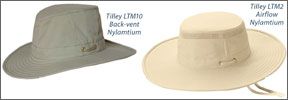
The polyester and ripstop Sun Goddess Booney is colorful and comfortable. There is no mesh for ventilation, but the fabric is lightweight and fairly breathable. The brim is padded, giving it some added stiffness and helping it to stay afloat long enough for retrieval. Unfortunately, the 3-inch padded brim, which offered Excellent sun protection, also absorbed quite a bit of water. In rain squalls, it sagged and interfered with the wearers vision. Dry times were long in tests.
Testers raised concern about the long-term durability of the ripstop fabric, particularly its vulnerability to a tear, but the hat held up in testing fairly well. It comes in nine bright colors.
The Packable Sonoma is made of 87-percent paper with polyester and braided straw. It is well-made, comfortable, and stylish, but it is not as packable as the name would suggest. The straw crown didnt bounce back as well as those made of synthetic fabrics.
The naturally vented materials allow airflow, and the material is flexible and giving, but there are no straps or cords for crown-size adjustments, so order the right size. The hat sinks and has a long dry time, but testers rated its shady brim highly.
Bottom line: Testers liked the natural airy comfort and chin strap of the stylish Sonoma straw hat; we Recommend it for those seeking a daysailing hat that is more stylish than sporty. The other Columbia hats are decent sailing hats, but they did not quite meet our ideal hat criteria in all conditions.
Sunday Afternoons
With each real-world and bench test, we became more impressed with the quality of the Sunday Afternoons hats: the Cruiser, Charter, and Adventure. All three feature Sunday Afternoons ShieldTek water-repellent fabric treatment and DermaSafe sun protection with a UPF of 50.
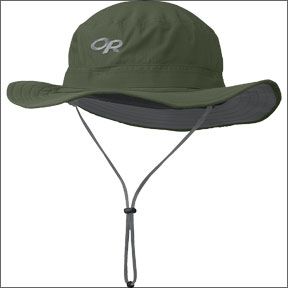
The lightweight, vented nylon Cruiser hat features a wide brim that is 2.5 inches around the front and sides, and it increases to 3.25 inches at the back, providing very good sun protection. Rows of stitching in the brim give it added stiffness that allowed it to stand up to a breeze well. A toggled cord snugs the hat at the crown, and a chin strap keeps the hat in place in a blow. A soft mesh lines the inside, acting as an integral sweatband. Testers found the design to be comfortable, and the lack of a standard sweatband shortened drying time. Nylon mesh circles the crown, offering Excellent ventilation. The hat floats and held up well in wear-and-tear tests.
The nylon Charter hat has similar high-quality construction, along with a stiffer brim that varies in width from 2.5 inches at the sides to 3 inches in the front and back, offering Excellent shade. The mesh circling the crown is multi-layered and thicker than that of the Cruiser. The Charter also has the added breathability of vented slits around the base of the crown. The Charter hat has a plastic slide buckle and strap inside the crown for size adjustment, as well as a hidden stash pocket and padding in the crown.
Sunday Afternoons Adventure hat comes highly recommended, with over 300 online reviews singing its praises. Testers were immediately taken by its lightweight, no-fuss comfort and terrific shade circumference. The downsloping front brim measures nearly 4 inches, and it tapers to 3.5 inches on the sides, where its attached to a neck flap. The brim has an internal wire to help keep its shape, and the neck flap can be rolled up and secured when not in use. All of this shade did not interfere with the wearers visibility in tests.

The hat features a sliding plastic clip adjuster outside the crown. The hat performed well in all durability tests, but if this clip were to break, the all-important fit would be compromised. The Adventure is priced at a very reasonable $38 and is available in 13 colors.
Bottom line: The hats are all well-made, adjustable, comfortable, and durable. We Recommend them all. The Adventure hat, with its over-all quality, comfort, and wide shade area, was selected as the Best Choice for sun protection. Its styling wont appeal to everyone, but for maximum shade and ventilation, it fits the bill.
Tilley
Tilley is well known for its construction quality and customer satisfaction, and the three Tilley hats we tested did not disappoint. The companys website is packed with positive reviews from devoted followers, travel tips, packing lists, and the anatomy of a Tilley hat. Numerous Practical Sailor readers have recommended the Tilley hat as the ultimate sailing hat. Tilley hats are guaranteed for life, with free replacement if the hat ever wears out, shrinks, or mildews. Tilley hats are also insured against loss: in their meet you half-way policy, if your hat is lost within two years of purchase date, Tilley will replace it at a 50-percent deduction. Each hat comes with a four-page owners manual; make sure to read the hat sizing instructions before choosing one.
We tested three of the over 100 hats on the Tilley website; two are nylon and one cotton. All three vented hats have a firm, wide brim with rows of stitching to help them keep their shape; a padded crown with hidden pocket; and a soft interior sweatband. Sliding the Tilley wind-chord knots tightens the chin straps and crown adjustment bands.

Both the LTM10 Back-Vent and the LTM2 Airflow hats are made from Nylamtium, a water-repellent supplex nylon. The T4MO Airflow is made from a soft organic cotton. The LTM10 features a multi-layered, soft mesh vent in the back half of the crown, along the top, while both Airflow hats have vents made of a stiff, woven polyester circling the entire top of the crown.
With the exception of the Adventure hat, which has a neck flap, the LTM2 Nylamtium Airflow had the largest brim in the test field. The brim is 3.5 inches in front and on the sides, and it extends to 4 inches for more protection over the neck. The T4MO organic cotton Airflow and Back-Vent hats have a slightly smaller shade perimeter.
Testers found the cotton Airflow to be the most comfortable of the three, and all held up well in the wear-and-tear tests.
Bottom line: It is hard to argue with the level of quality and the long-term customer satisfaction that Tilley deservedly enjoys. After putting the three Tilley hats through their paces, we can recommend them all, but the ultra-comfortable organic cotton Airflow gets the pick for Best Choice, tying the Adventure for the best sailing hat with sun protection.
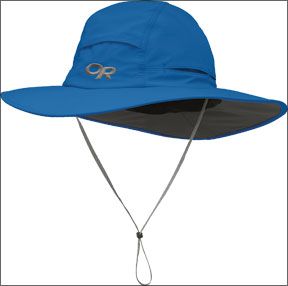
Outdoor Research
Outdoor Research (OR) receives high marks from its customers and has won several awards from independent reviewers. We tested three OR hats: the Seattle Sombrero, the Sombriolet, and the Helios. The Gortex nylon Seattle Sombrero seems more of a rain hat than a sun hat, in our opinion. It offers water-resistant protection and a wide, stiff brim that directs water away from your face during a downpour. That same 3- to 3.5-inch brim can shade you from the sun, but the soft, polyester-lined interior that offers comfort and warmth for cooler climates, was a little too heavy for Floridas summer sailing conditions.
Wearers can velcro the brim sides out of the way, and a velcro strap inside the hat snugs it around the head. The hat absorbed water once dunked, and when the hat was submerged, water pooled and was trapped in the interior pockets, resulting in the longest dry time in our test field.
The lightweight, nylon Sombriolet sun hat offers a wide shade circumference that varies from 3 inches at the front to 4 inches at the neck, offering great sun protection. The interior has a loose polyester-mesh liner and a very soft headband. The crown exterior has six large vents to allow air to flow through the mesh liner and for sweat to escape. A toggled cord adjusts the crowns fit, and the foam-stiffened brim floats the hat. The Sombriolet is available in seven trendy colors.
At 2.5 inches all around, the nylon Helios hats brim offers a smaller shade area. The foam brim is stitched for enhanced stiffness, and it keeps the hat afloat. The lightweight hat is comfortable and breathable, but it has no vents or liner. It does have a very soft inner headband and a toggled adjustment cord at the crown.
Bottom line: The Seattle Sombrero would be a practical all-weather hat in areas that are cooler and have frequent rain, like its namesake Seattle, but it is too heavy for the tropics. The nylon Sombriolet and Helios sun hats were comfortable and offered decent shade.
Gill
Gills new Technical UV Sun Hat (140) is a lightweight, water-resistant nylon hat with no bells and whistles. It comes in two sizes (23 and 24 inches), the crown can be snugged via a toggled adjustment cord; the chin strap has a sliding plastic adjuster, but no toggle.
Less expensive than most other hats in the test field, the comfortable, functional Gill was not particularly captivating right out-of-the-box. But after multiple rounds of wear-and-tear testing, the Gill hat remained solid while some of the other inexpensive hats were unraveling.
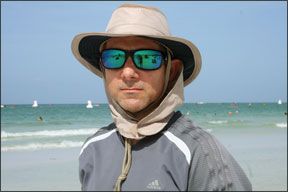
Bottom line: Offering great comfort and decent protection at an affordable price, the Gill hat is our Budget Buy.
Cov-Ver
Similar in style to the Tilley hat, the polyester Cov-Ver Supplex Boaters Hat features an exterior water-repellent coating and a long strip of airflow mesh around its crown that provides limited ventilation. The hat has foam padding and a hidden stash pocket in its crown. It also has a nylon neck flap that velcros in the front to keep it in place. Testers noted that the flap provided great protection for the neck, but it did not fully cover the wearers ears. The oblong-shaped brim was stiff enough to handle light breezes without flopping. The Cov-Ver safari hat is available in four sizes (21 to 24 inches). Cov-Ver sells its hats wholesale, but you can find them online (www.killerhats.com) and at boat shows or chandleries.
Bottom line: A comfortable hat with a decent shade circumference and neck flap, the Cov-Ver hat had average performance in the wear-and-tear tests. Testers had a harder time locating the Cov-Ver for retail than other test hats.
Conclusion
No hat will suit all types of sailors, and our large test field compared some with distinctly different features. The lightweight, well-ventilated Sonoma might suit the sweaty South Florida sailor, while the fleece-lined Seattle Sombrero may best suit those tacking off the Oregon coast.
Most sailors agreed that the most important criteria in choosing the perfect sailing hat were fit and comfort, followed closely by sun protection and performance on board. (Remember to check the fit while wearing your sunglasses, as that may affect comfort.) Most testers also agreed the wearer had to like the hats aesthetics as well-with so many hats on the market, it is possible to find one that performs well and looks good (in the eye of the beholder).
Dunking the hats, floating them, washing them and drying them really brought out the test fields range of construction quality. We found that some hats that were terrific right off the shelf did not hold up well for the long-term, with stitching fraying and the material looking worn after multiple dunkings and washings.
The Tilley and Sunday Afternoons hats were clearly tops in the quality department, while the Gill surprised testers with its durability. Testers Recommend the Tilley and Sunday Afternoons hats we tested, but the Tilley Organic Cotton Airflow and Sunday Afternoons Adventure tied for our top pick, the PS Best Choice. Columbias Sonoma straw hat earned a Recommendation for those seeking a more natural, less sporty hat, and Gills durability at an affordable price range earned it our Budget Buy pick.
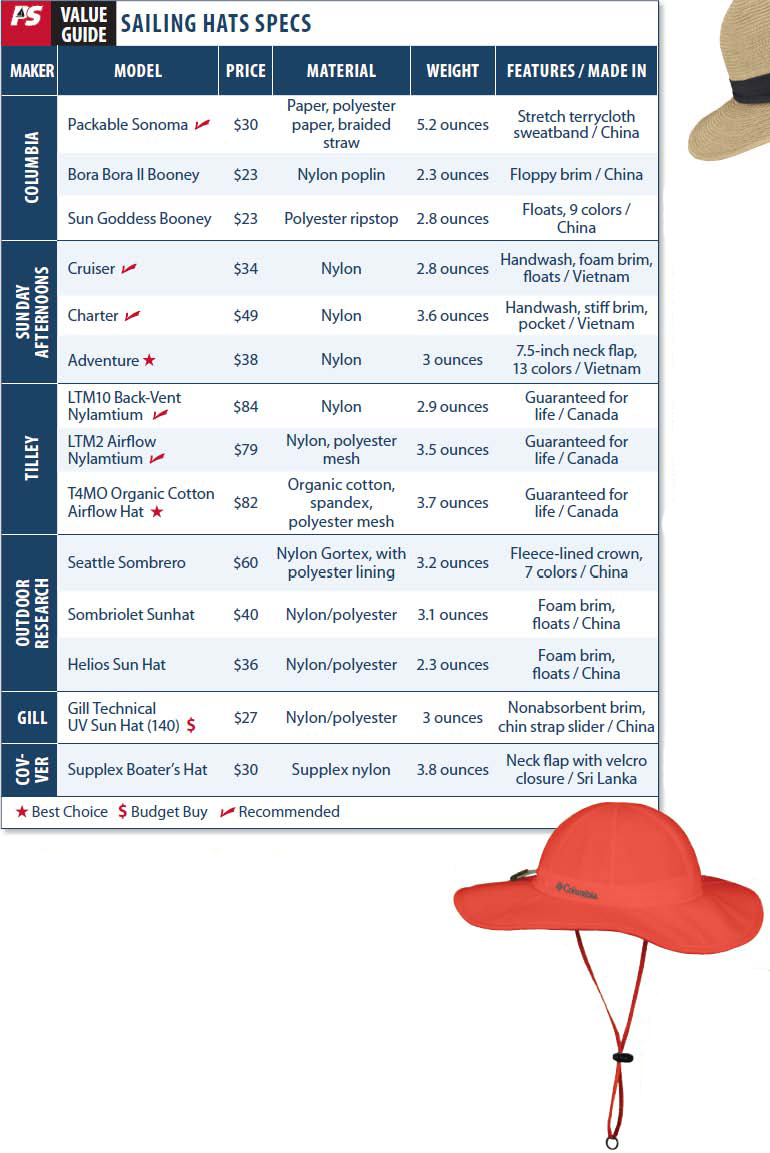






































Thanks for explaining that, depending on the location, we’ll need to get a hat that’s ventilated, waterproof, or both. My husband and I are looking into booking a boat charter for ourselves and our two kids before summer’s over so we can get some quality time together outdoors. Since I haven’t done a boat charter before, your advice about what to wear should help me stay as comfortable as possible and enjoy the experience!